Rogue One, about a band of fledgling Rebels who attempt to steal the Death Star plans, holds the distinction of achieving something no Star Wars film had since A New Hope: it became a surprise hit. Well, OK, not exactly. As only the second Star Wars feature film to hit theaters since 2005, everybody knew it would make money no matter what. But there were lots of questions and some pessimistic predictions. Given the troubled production that required Disney to bring in Tony Gilroy and his team to do more than the usual amount of eleventh-hour tinkering and reshoots, as well as the fact that the movie featured mostly new characters, Disney was likely not banking on A Force Awakens nostalgia-drenched success.
But Rogue One became an enormous hit despite the stumbling blocks. It’s still in 15th place on the all-time domestic box office list, though its international haul was less than desirable by industry standards, especially given the diverse cast of international actors representing a variety of marketplaces, er, I mean countries. And the reviews were decent, though critics seemed more relieved and surprised that it wasn’t terrible given all the prerelease turmoil. There was still plenty of grumbling among reviewers, with The New York Times complaining that the movie sported a “surprisingly hackish script.”
Especially considering it could have been a catastrophe, Rogue One was an unequivocal triumph, perhaps goading Disney into a false sense of confidence about what was possible — and what audiences would accept — from Star Wars, as Gilroy himself recently said. Almost six years later, looking at the film with fresh eyes on the eve of Gilroy’s spinoff show, Andor, does Rogue One hold up? Does it both “give good Star Wars” and also work as a solid movie in its own right?
Stunning visuals
To begin, this is a beautiful film. I keep a mental list of movies that would look fantastic playing without sound in the background of a fancy party (which I will one day host if I ever get a bigger place and, you know, friends). Rogue One is on that list, along with Tron Legacy, Atomic Blonde, John Wick: Chapter 2, and the live-action version of Ghost in the Shell with Scarlett Johansson. Yes, I realize this last one is sacrilegious for a number of reasons, but the point is — with the exception of John Wick 2 — these are fabulous-looking movies that you wouldn’t necessarily want to also hear, given their middling stories. I’m afraid that goes for Rogue One as well, but first let’s praise the good stuff, including the visual imagination on display.
I don’t just mean expensive special effects, which every blockbuster contains. I mean that every frame of Rogue One is lushly photographed and the production is generous in the many stunning locations in which it stages the action. Star Wars producers are always looking for new environments and they found one of their most unique in the Reynisfjara Black Sand Beach where the opening sequence is filmed. The Imperial shuttle whirring over the shore towards the lush green and cobalt black inland feels alien, which you can’t always say about Star Wars environments like Endor and Hoth.
The beach battle of Scarif is likewise both fresh and visually striking with its turquoise water and AT-AT’s nosing through swaying palm trees as though the Empire had invaded the Florida Keys. Both sequences also contribute nifty additions to the ever-growing coterie of stormtrooper types with Death Troopers and Shore Troopers, respectively. And let’s be honest, a Star Wars movie isn’t doing its job if we don’t want to rush out the moment it’s over and buy the new toys.
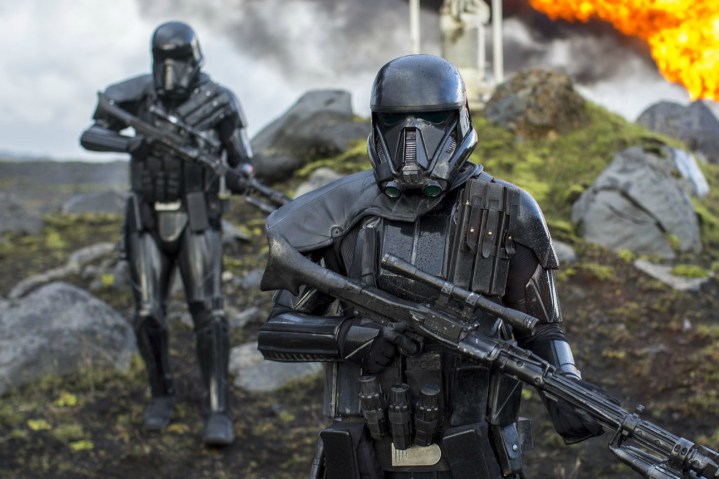
Not surprisingly, given that the film was the brainchild of special effects artist John Knoll, Rogue One contains some of the best-realized special effects in any Star Wars production. George Lucas was always trying to remake the ideas he had in his head with newer VFX technology, not only in the late ’90s Special Editions but also by giving Return of the Jedi and The Phantom Menace more or less the same ending as his original film. His vision for the space battles at least may have finally been realized in Rogue One. It’s hard to imagine they can get much better than this, until we get virtual reality anyway.
As with the earlier pictures, there’s nothing narratively new with the Rebel fleet trying to buy time for the heroes to infiltrate the fortress on the ground, but who cares if it’s this thrilling and gorgeous? The moment when a “Hammerhead Corvette” cleaves one Star Destroyer in two with another remains one of the more impressive staged moments in all of Star Wars. Another stunning moment occurs when the Death Star blows up the city of Jedha and the movie depicts both the awe-inspiring power from space and the sheer overwhelming terror of those facing it on the imploding ground. It’s a major upgrade from the pew-pew destruction of Alderaan in A New Hope and a testament to what special effects can do when rendering imagination rather than replacing it.
Gilroy’s contributions
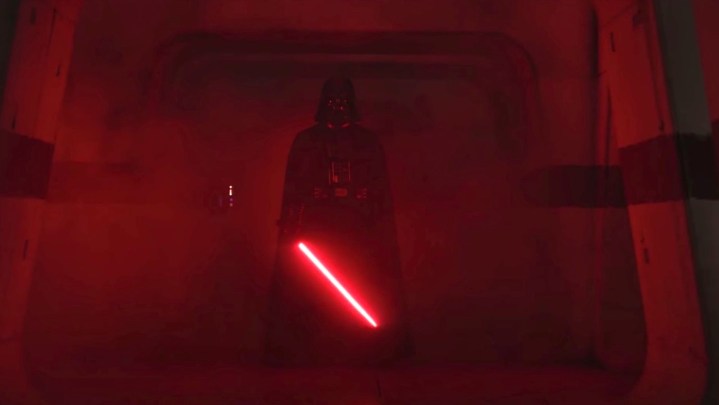
There’s little doubt that Gilroy’s work on the film probably saved it. Among his reported additions was the instantly iconic scene in which Darth Vader saws his way into a corridor and savagely dispatches a band of terrified Rebels. The ferocity felt exiting and new – the kind of Vader we should have had but that couldn’t exist before filmmaking innovations made him possible. The final shot of Vader standing on the edge of a docking platform, gazing after his prey, does more even than the lightsaber melee to establish the Dark Lord as someone so badass he’s completely undaunted by the raw vacuum of space itself.
The scene has been influential, to say the least. Surely it led the makers of Obi-Wan Kenobi to try to up the stakes with a Vader slaughter tantrum of their own. The Mandalorian also features a version, when Luke Skywalker lightsaber-hacks his way through a corridor in a similar fashion (hopefully it was meant as a homage and not a rip-off, but you never can tell with that witless production).
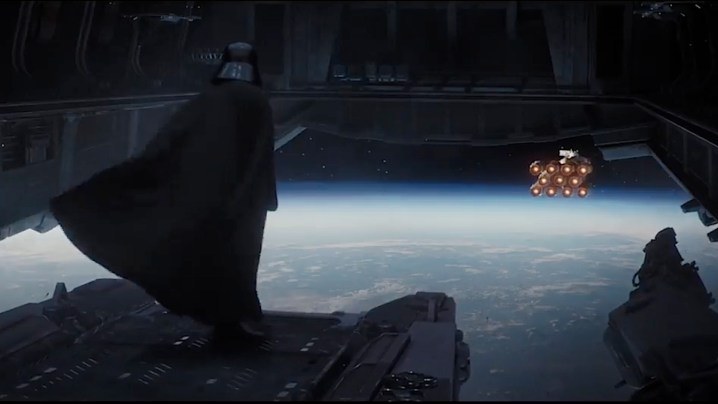
Gilroy also added Cassian Andor’s (Diego Luna) introduction, when he kills a wounded fellow Rebel who is slowing them down during an escape. For my money, this remains the most shocking moment in Star Wars. There are other candidates: the climax of The Empire Strikes Back, both the big parentage reveal and Luke casting himself into the abyss when he learns of it; Anakin Skywalker slaughtering Sand People in Attack of the Clones; Anakin’s delimbed and scorched body at the end of Revenge of the Sith. But we expected these things from Vader. We knew what he was capable of, how much hate was in his heart.
Andor executing his comrade – which he does instantly and almost casually once he realizes it’s his only way out of Imperial entanglement – threw the entire idea of sacrifice for the Rebellion into a new light. We realized, seeing it for the first time, that not every hero will be remembered, let alone lionized with a medal ceremony. More crucially, we understood that dirty deeds may be required to keep the nascent Rebellion going. It’s a more ruthless and dispassionate act than anything the supposedly mercenary (but actually warm-hearted) Han Solo ever contemplated.
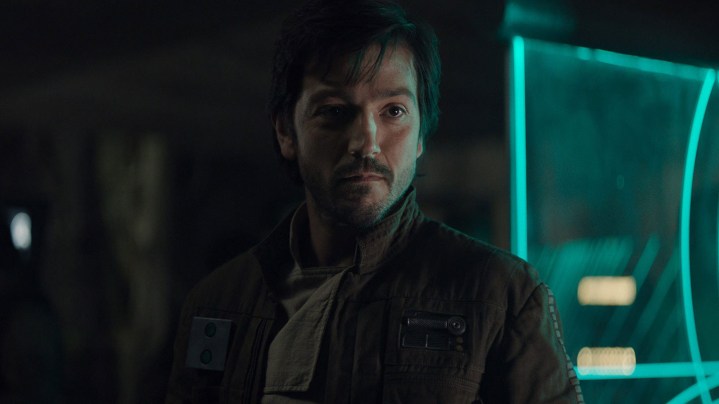
The fact that it happens so early in the film signals that Rogue One will have a different tenor, that it will dramatize something of the realism of making hard decisions under impossible conditions, and that it may signal a Star Wars story that isn’t stuffed full of cute and funny like The Force Awakens, which was still present in people’s memories when Rogue One came out. It was a bold and inspired moment. Does the rest of the film live up to the potential for new Star Wars directions it unfurled?
6 years later, does Rogue One still hold up?
Yes and no. Anybody seeing the movie for the first time can tell you how surprised they are by the ending. It takes the harsh reality of the violence and sacrifice in that first scene to its logical conclusion. Also, it befits the genre. Heroes die in war movies all the time. Think of Tom Hanks’ Captain Miller in Saving Private Ryan succumbing so he can save Matt Damon’s titular hero.
Ironically, given that they are building an entire show around him, Andor may be the least interesting of the film’s main characters, mostly because the script fails to imbue him with any warmth. I get it, he’s a jaded insurrectionist in a dirty jacket, not a yearning and lust-addled teenager like the one Luna played in his charming breakout role in Y tu mamá también. Still, it would be nice if our Rogue One hero felt a little more, well, roguish.
The characters, in general, are the weakest part of the movie. Gilroy has said he saw Rogue One less as Star Wars and more as a “Battle of Britain” movie. And like a lot of war movies, the characters – many of whom are fated to be cannon fodder – are somewhat indistinct; surely they take a backseat to the action and the visuals. It was true in 1969 when Guy Hamilton made the actual Battle of Britain movie with its spectacular aerial action, and it is true for Rogue One.
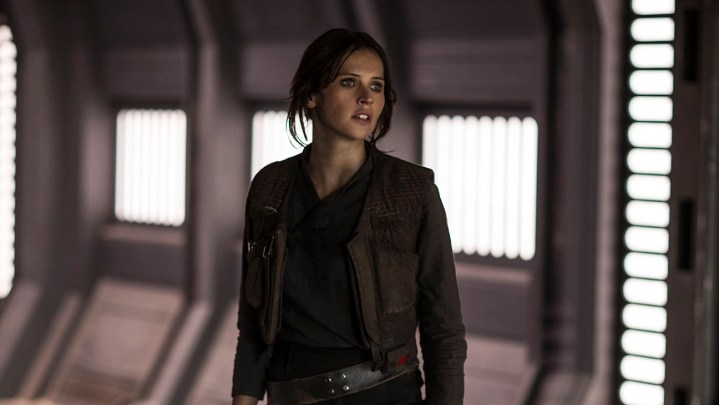
Felicity Jones as the plucky Jyn Erso is fierce in the role, but also humorless. Jyn has also had a rough time of it. She watched the Empire gun down her mother, she was abandoned by her father, then raised by a terrorist — her childhood was probably woefully short of graham crackers and sleepovers. But a sense of humor sure makes those tough times more bearable. A few war-weary cracks between her and Cassian, as opposed to their constant squabbling, would make their final moments together feel a little more intimate.
Among the other main characters, Donnie Wen and Wen Jiang have a nice rapport as a couple of monks turned commandos. Typical for Star Wars, a non-human character steals the show. As the voice of the Imperial droid K-2S0, Alan Tudyk provides the same droll wit that Phoebe Waller-Bridge would a few years later as a droid in Solo.
Conversely, Riz Ahmed as the pilot Bodhi gets little to do but recite exposition. There’s no sense that he would quickly be considered one of the best actors of his generation in work like The Night of and Sound of Metal. Another great actor, Ben Mendelsohn, is also somewhat wasted as the Imperial Big Bad, Orson Krennic. Mendelsohn has played many memorable villains (Animal Kingdom and Bloodline), but despite looking rakish in his white cape, both the character and the performance are mostly a lot of foot-stamping and browbeating that goes nowhere.
Another disappointing aspect of the film is the music. Michael Giacchino has proven himself worthy of becoming a top film composer with stellar work in films like Star Trek (2009) and The Batman, but his score for Rogue One feels as generic as some of the characters and action. It’s not surprising, given that Giacchino only had a few months to compose it.
Giacchino became the first composer to score a Star Wars movie other than John Williams and I can’t understand why William’s legendary music wasn’t just reused. I get that Rogue One was trying to establish its own identity — one of the reasons why it was also the first Star Wars film to dispense with the famous opening crawl. But when you’re already recycling so much else out of the back catalog, why not just add everybody’s favorite film music as well?
In the end, Rogue One — like virtually all of Star Wars save for that unblemished masterpiece, The Empire Strikes Back — is a mixed bag. The script does indeed feel “hackish” at times. But ultimately the movie flies on the strength of spectacular visual imagination and on bold character moments included by Gilroy. Hopefully, moments like those make the upcoming Andor into something special and possibly even succeed where its predecessor movie sometimes failed.




